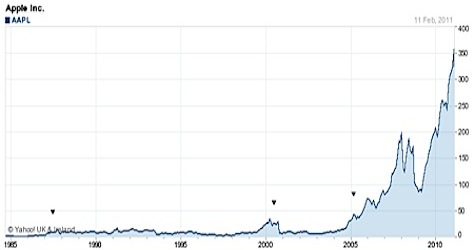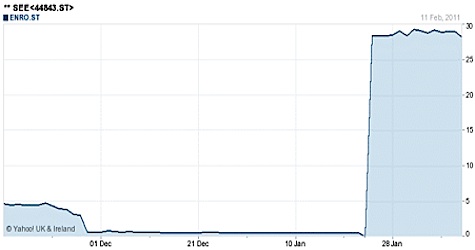Editor’s Thoughts: I’ve been pretty specific about my stance on penny stocks. I’ve given reasons why I believe that buying penny stocks is a big mistake, particularly for average investors. I’ve also discussed why this type of trading is not for me. But I’ve invited Tony Loton, a private stock trader and financial writer, to give his views on investing in penny stocks, and he has obliged. So I present to you some different views on this intriguing topic.
Much has been written on The Digerati Life and elsewhere about the dangers of investing in so-called “Penny Stocks”. They are hard to research, aggressively sold, and thinly traded. In short, they are prone to manipulation and are easy for the existing (professional) holders to “pump and dump” on regular investors like you and me.
Can We Invest In Penny Stocks With Care and Caution?
Sure, with many caveats. In this article, I’d like to present an alternative view that suggests we might be able to benefit from the upside potential of penny stocks without taking undue risks… provided we do it right.
1. Know how to interpret stock price.
Price is what you pay and Value is what you get. Just because a stock is priced low, this doesn’t mean that it represents good value. I can buy cheap sausages at the market, but they’re not particularly good value if they’re all rusk and no meat. On the other hand, the butcher might have his own very good reason for selling his previously high value meats at temporarily knocked-down prices, just as in the market lows of March 2009 you could buy some blue-chip stocks at almost penny stock prices. You might be able to pick up some cheap stock today and sell it for its true value tomorrow.
The very same butcher might have an introductory offer on his brand new never-been-tasted-before “elephant burgers”. Buy a load of these now before they catch on, and you might just make a killing when they become the next big thing. Alternatively, you could be left with a garage full of impossible-to-sell rotting meat, and there’s pretty much nothing in between.
Note: Penny stocks are something of an all-or-nothing proposition.
2. Know that penny stocks are all about timing.
Large cap stocks have slower growth: that is, elephants don’t gallop. Sure, your basket of big name stocks is safe and reliable, and a good way to preserve existing wealth, but it’s never going to make you rich if you aren’t already rich. As investment legend Jim Slater once famously put it: “Elephants Don’t Gallop.”
Now that the price of Apple stock is priced up in the stratosphere, you are unlikely to ten-bag your investment by buying shares now. But look what would have happened if you had bought those very same Apple shares at a bargain basement price as recently as 2004. This company could easily have gone bust back then, but it didn’t, and now you’re kicking yourself out of frustration that you missed a 35-bagger.

AAPL Stock Chart
Over a much shorter timescale, see what would have happened if you had bought shares in Swedish company Eniro priced at just 0.6 –- in whatever currency it was, the units don’t matter –- on 21 January 2011. I did, and only four days later my holding was worth a massive 47 times more! But I didn’t become a millionaire virtually overnight, because I played safe and small.

Eniro Stock Chart
Note: If you don’t want to play the timing game, then don’t dabble in penny stocks.
3. Diversify to control risk, as always.
Diversification is key to managing any kind of risk. This point has been covered in this site, time and time again — and it’s the same story regardless of whether you’re involved in passive investing with index funds, active investing with mutual funds or ETFs, or even investing in penny stocks. If you’re wondering how I was clever enough to guess right on Eniro stock, but the answer is that I wasn’t. I merely took a scattergun approach by establishing small stakes in many low-priced stocks on the basis that few star performers would outweigh the many basket cases. Every 35-bagging stock allows me to hold up to 35 other penny stocks that go to the wall. Diversification is one way to de-risk (or lessen the risk of) penny stock trading, by not betting the farm on a single hot tip.
4. Start small and build up.
Spreading your funds across many penny stocks will usually imply that you’ll be “starting small” in each stock. That’s not a bad thing, but as I hinted earlier, it worked to my detriment in the case of Eniro. I started very (very) small in this stock and therefore made only a small amount of profit in absolute terms. If you invest $100 and then go on to 35-bag your money (lucky you) your final $3,500 holding doesn’t exactly put you in the high roller category. The problem was that the price of this stock appreciated too quickly.
In contrast, consider that en route from 10 to 350 and as the upward momentum developed, there were plenty of opportunities to pyramid into Apple shares so as to increase your stake to something more meaningful. Just remember to lock-in some of your accrued profits along the way by using a stop order.
The Bottom Line on Penny Stock Investing
Participating in penny stock investing is risky but can be rewarding. You can chase those rewards while taking less risk by diversifying, starting small, and building up. I will say though, that this type of investing is not for the inexperienced or for hands-off investors. Be careful out there!
Copyright © 2011 The Digerati Life. All Rights Reserved.

{ 10 comments… read them below or add one }
Regarding AAPL, which you mention in your article — yes, I own it. Plus, my brother bought it the morning before the iPhone pop. I have to say that I took some pain before I got my redemption. Now, to find the next one…
Good for you Brian! My co-workers would be so envious of you. One of them had sold AAPL a while back and made no money.
About Apple: I guess now the question would be: “did you sell Apple ‘on the news?’” Of course, I did not. I had Apple at 88 before the IPhone news (but also before it went down to about 85.) Between the news and the earnings, I thought for sure, it had reached a point where it wasn’t going down, but staying in up territory. I actually thought if I hold it for this year, I could probably make a healthy 15-25% return based on predictions of $110.00 a share and my own decision about when to sell it en route to $110.00 a share.
Now, I don’t know if we’ll see 110 a share this year (although I think it will go to that if the newspapers would stop hating on it). We’ll see. My husband and I decided that if it backs up to the $98.00 range soon, we’ll sell; if not, we’ll probably hang in there long term — it is definitely a great company if it didn’t have that options cloud hanging over its head.
Marketgrader has a platform that analyzes and rates the fundamentals of every company on the DJ-TSM index. It is a great way to put the ideas in this post into action, as it identifies fundamentally sound companies and can help you put together a diverse portfolio.
I used to receive a newsletter about what to buy. Five years ago, I bought one stock for $3.46. It’s now worth 12 cents.
I had always wanted to invest in penny stocks, but had never gotten around to it. Then one day, I happened to see that WorldCom stock was selling for 5 cents per share. They still had a chance of coming back, so I bought 10,000 shares.
Needless to say, I was cured. :–)
You guys (or girls) are right about the dangers, which is why I suggested to “diversify” and “start small and build up”. Don’t bet the whole farm on the next Worldcom!
Thanks for your comments.
Tony Loton (article author)
@Donna,
It’s been a while since your comment on AAPL, but it looks like you’ve done really well with the stock. Congrats! As for penny stocks — I’m quite wary of trying it out. I actually got screwed by one penny stock pump and dump scheme before, so I’ve sworn not to touch such stocks ever again… unless I first devote the time to better understand this type of stock.
@Silicon Valley Blogger,
Understanding the incentives is most important to investing in penny stocks. The two most important factors to understand are:
a) never invest what you can’t afford to lose and
b) never get greedy.
Pump and dumps are so common with penny stock promoters but there are some that notify interested investors of companies that are actually value companies that sustain their gains. In October alone, we saw great gains in ANDS (323%), INHX (268%) and PEIX (86%) since their alerts were publicized. Quality companies who sustain their increase in shareholder value.
Hope you find the right information sources one day to profit from penny stocks.
~Pabs at aimhighprofits.com
@Pabs,
Thanks for the tips. Yes, these are helpful. I’m interested in checking out your site (aimhighprofits.com) as well. I’ll give it a peek and see what type of guidance you guys are providing investors.